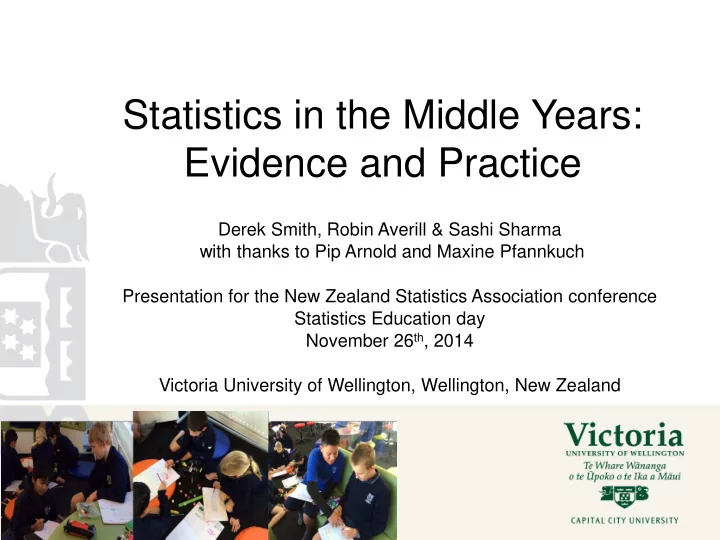

Statistics in the Middle Years: Evidence and Practice Derek Smith, Robin Averill & Sashi Sharma with thanks to Pip Arnold and Maxine Pfannkuch Presentation for the New Zealand Statistics Association conference Statistics Education day November 26 th , 2014 Victoria University of Wellington, Wellington, New Zealand
Overview • Overview of book • Values and themes across the book • Statistics education focus Describing Distributions Statistical Literacy • Sample activities
Mathematics and Statistics in the Middle Years: Evidence and Practice • each chapter relevant across Years 7-10 • schools and academics involved from around New Zealand • 18 chapters (56 authors – teacher academic partnerships) • 60 reviewers (teachers, academics, and student teachers) • Published by NZCER early 2015
Mathematics and Statistics in the Middle Years: Evidence and Practice Four values through the chapters towards equitable statistics and mathematics education: respect developing leadership community inclusion And a further theme: use of digital technology
Describing Distributions Chapter 14 Pip Arnold and Maxine Pfannkuch Kaua e mate wheke mate ururoa Don't die like an octopus, die like a hammerhead shark http://www.maori.cl/Proverbs.htm
Overview • Describing distributional shape – Students sketch the distributional shape of graphs and then group them, from here the two main aspects of shape description are “discovered”, symmetry and modality • Predicting distributions – Given the variable and the population students sketch their prediction of the distribution • Describing distributions – Aspect of distributions are considered and described for the different situations, considering context: VARIABLE, VALUES and UNITS
Predicting distributions • Work with your partner to sketch the distribution for the following three situations – Attendance in percentage half days, year 9-13 students – Hair length in cm: year 4-13 students – Age in years: everyone at a high school
Attendance percentage half days 20 40 60 80 100
Hair length in cm mple 0 20 40 60 80
Age of everyone at a high school 10 20 30 40 50 60 70
Enhancing Statistical Literacy through Critical Questions and Real World Examples Chapter 12 Sashi Sharma, Phil Doyle, Viney Shandil, and Semisi Talakia’atu Nāu te rourou, nāku te rourou, ka ora te manuhiri From your food basket and from mine, the people will thrive. http://www.korero.maori.nz/forlearners/proverbs.html
What is Statistical Literacy? Statistical literacy is the ability to interpret results from studies and media reports and to be able to pose critical and reflective questions about those reports.
Components of Statistical Literacy Interrelated knowledge bases: • mathematical knowledge • statistical knowledge • knowledge of the context • literacy skills • critical questions Dispositional elements: • beliefs and attitudes • a critical stance
Statistical Literacy Learning Environment • Use real data and classroom activities to engage students • Stress conceptual understanding rather than mere procedures • Foster active learning • Promote classroom discourse • Use a range of assessment to improve and evaluate learning
An Example: Texting “A typical teen sends about 50 texts a day,” 2009 • Introduce the context: literacy focus • Small group work • Wrap-up discussion • Brief assessment task
Points to Ponder • How would your students react to the claims made in the Texting activity? • What are some advantages and limitations of using media reports in the classroom?
Mathematics and Statistics in the Middle Years: Evidence and Practice Four values towards equitable statistics and mathematics education through the chapters: respect developing leadership community inclusion And a further theme: use of digital technology
Mathematics and Statistics in the Middle Years: Evidence and Practice Also included in the book: a range of ideas for teaching and learning of algebra, number, geometry, measurement Equitable teaching, SOLO taxonomy, maths for environmental justice, science through mathematics (rocket maths), traditional M āori systems and language of spatial orientation, mixed ability, mathematical discussion, peer tutoring, challenging tasks, using show and tell technology, large numbers...
Mathematics and Statistics in the Middle Years: Evidence and Practice Further ideas for digital technology for statistics teaching and learning also included in the book: Addendum Apps, e.g., ‘Quick graph’ ‘Simpulse StatCalc’ and Web 2.0 tools, e.g., ‘Socrative’
Develop an understanding of the integration and use of web based tools and apps for student and teacher devices The use of technology in the internally assessed Achievement Standards. KhanAcademy
Questions
Recommend
More recommend